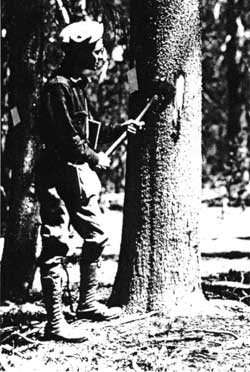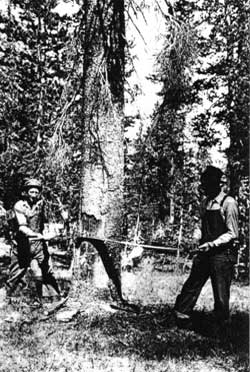Keen sent Patterson a copy of his 1929 report and a long letter on Oct. 6, 1929, saying “It is awfully hard to write up anything that you haven’t first hand knowledge of and I’m afraid I have done a pretty sorry job of it.” [19] It actually was the most succinct and penetrating analysis of the situation thus far. Keen also told Patterson that though he (Keen) advocated a somewhat revised policy, he still recommended a continuation of the protection of special park areas. He also admitted that it was not an attempt to eliminate the beetles from the south end of the park. He told Patterson that they must “abandon all of the isolated areas and concentrate on the protection of those areas where the fire hazard is the highest and are of the most value from the recreational standpoint—in other words the areas where most of the control money has already been spent” (see footnote 19). There is no record of a reply by Patterson to this letter in the files.
The year 1929 is a good year from which to draw a picture of the control camps, equipment, and personnel employed during the spring treating period. In a memo [20] to the Superintendent of Crater Lake National Park, Patterson suggested the following arrangements for 1929:
Control Camps. The personnel of each camp should consist of the following: 1 camp foreman, 1 cook, 1 compassman, 2 spotters, and 14 treaters.
However, the number of treaters may be increased to 20 if conditions warrant. The one spotting crew of 3 men can easily keep ahead of 10 treating crews of 2 men each.
Equipment. Each Camp:
Cook tent; stove and necessary utensils for feeding the men.Provisions
Tents for sleeping quarters, including cots and mattresses.
Tools (based on camp of 1 spotting crew and 14 treaters):
1 Staff Compass
2 Spotting Axes
1 8×10 Tatum Holder
2 5×8 Tatum Holder
Section plats and spotters’ record sheets
Timber Crayons
14 double-bitted axes (bastard)
7, 6 1/2-ft. combination falling-bucking saws
15 canthooks
1 light truck for use of the foreman in transporting men to and from work and for hauling supplies. (If it is necessary to do the work before snow has disappeared the truck can not be used and transportation effected by tractor and sleds. In this case it would be limited to moving camp equipment in and supplying camp with provisions.)



